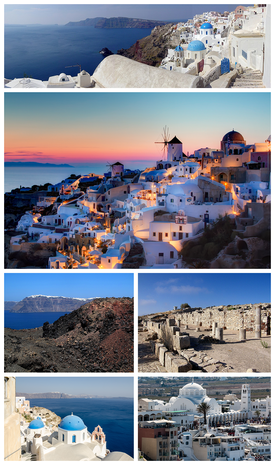
Back Santorini ALS سانتوريني Arabic جبل سانتورينى ARZ Santorini Azerbaijani Сантарын Byelorussian Санторини Bulgarian Santorini (ostrvo) BS Santorí Catalan Santorini Island CEB Théra (ostrov) Czech
Santorini
Σαντορίνη Θήρα | |
|---|---|
 Clockwise from top: Partial panoramic view of Santorini, sunset in the village of Oia, ruins of the Stoa Basilica at Ancient Thera, the Orthodox Metropolitan Cathedral of Ypapanti (it) Cattedrale della Presentazione di Cristo (Fira) at the town of Fira, the Aegean Sea as seen from Oia, and view of Fira from the island of Nea Kameni at the Santorini caldera. | |
| Coordinates: 36°24′54″N 25°25′57″E / 36.41500°N 25.43250°E | |
| Country | Greece |
| Administrative region | South Aegean |
| Regional unit | Thira |
| Government | |
| • Mayor | Anastasios Zorzos[1] (since 2023) |
| Area | |
• Municipality | 90.69 km2 (35.02 sq mi) |
| Population (2021)[2] | |
• Municipality | 15,480 |
| • Density | 170/km2 (440/sq mi) |
| • Municipal unit | 14,393 |
| • Community | 1,516 |
| Time zone | UTC+2 (EET) |
| • Summer (DST) | UTC+3 (EEST) |
| Postal code | 847 00, 847 02 |
| Area code(s) | 22860 |
| Vehicle registration | EM |
| Website | www |

Santorini (Greek: Σαντορίνη, romanized: Santoríni, pronounced [sa(n)doˈrini]), officially Thira (Greek: Θήρα, romanized: Thíra, pronounced [ˈθira]) or Thera,[a] is a Greek island in the southern Aegean Sea, about 200 km (120 mi) southeast from the mainland. It is the largest island of a small, circular archipelago formed by the Santorini caldera. It is the southernmost member of the Cyclades group of islands, with an area of approximately 73 km2 (28 sq mi) and a 2021 census population of 15,480. The municipality of Santorini includes the inhabited islands of Santorini and Therasia, and the uninhabited islands of Nea Kameni, Palaia Kameni, Aspronisi, Anydros, and Christiana. The total land area is 91 km2 (35 sq mi).[3] Santorini is part of the Thira regional unit.[4]
It is the most active volcanic centre in the South Aegean Volcanic Arc. The volcanic arc is approximately 500 km (300 mi) long and 20 to 40 km (12 to 25 mi) wide. The region first became volcanically active around 3–4 million years ago,[citation needed] though volcanism on Thera began around 2 million years ago with the extrusion of dacitic lavas from vents around Akrotiri. One of the largest volcanic eruptions in recorded history struck the island about 3,600 years ago, leaving a large water-filled caldera surrounded by deep volcanic ash deposits.
- ^ Municipality of Thira, Municipal elections – October 2023, Ministry of Interior
- ^ "Αποτελέσματα Απογραφής Πληθυσμού - Κατοικιών 2021, Μόνιμος Πληθυσμός κατά οικισμό" [Results of the 2021 Population - Housing Census, Permanent population by settlement] (in Greek). Hellenic Statistical Authority. 29 March 2024.
- ^ "Population & housing census 2001 (incl. area and average elevation)" (PDF) (in Greek). National Statistical Service of Greece. Archived from the original (PDF) on 21 September 2015.
- ^ "ΦΕΚ A 87/2010, Kallikratis reform law text". Government Gazette (in Greek). Archived from the original on 23 October 2021. Retrieved 7 September 2021.
Cite error: There are <ref group=lower-alpha> tags or {{efn}} templates on this page, but the references will not show without a {{reflist|group=lower-alpha}} template or {{notelist}} template (see the help page).

